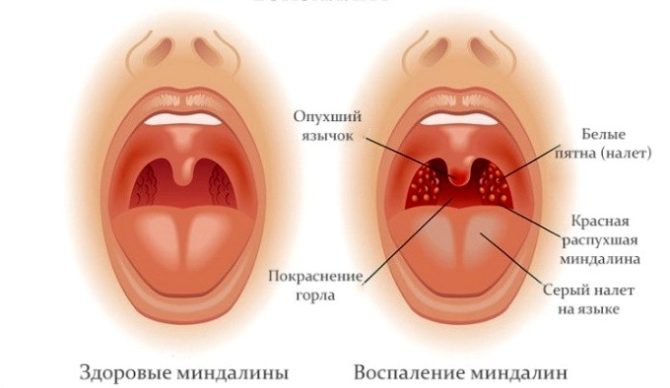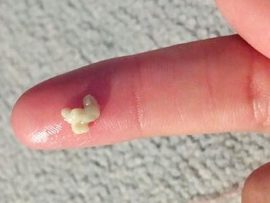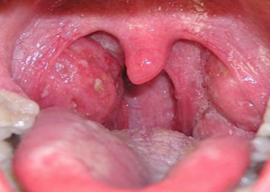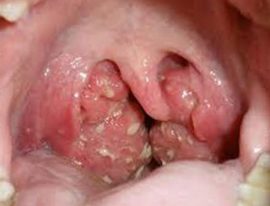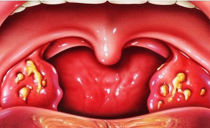Tonsilitis plugs in the throat: how they look, causes, treatment
Having contracted acute angina, many people do not give it due attention and are treated at home. However, tonsillitis is what the inflammatory process in the tonsil region is called in medicine, often leads to complications. One of them is the formation of tonsilithic plugs in the gaps of organs, which are difficult to treat. Sometimes the most radical measure is applied to them - surgical removal.
Content
- A bit about tonsils: anatomy
- Tonsilithic plugs: how they look and why they form
- Why traffic jams arise: background and etiology
- Concomitant symptoms
- Diagnosis of the disease
- Conservative therapy
- Physiotherapeutic procedures
- Traffic Removal
- Treatment of caseous traffic jams at home
- Features of treating children
- Preventive actions
A bit about tonsils: anatomy
Tonsils (tonsils) are made up of lymphoid tissue and are streaked with deep, sinuous channels called lacunae. The latter turn into large crypts that permeate the entire organ. The glands are located in the nasopharynx and oral cavity, that is, right in the path of respiratory infections. Hence their main function is to protect the body from the penetration of harmful agents.
Both the lacunae and the crypts of the tonsils have a large area, so everything that enters them from the outside has long contact with the lymphoid tissue, which stimulates the production of antibodies. In healthy people, the glands are independently cleared of white blood cells, dead microbes and desquamated epithelial cells. All this mass is secreted into the oral cavity, swallowed with saliva and destroyed in the gastric juice.
Tonsilithic plugs: how they look and why they form
If especially dangerous bacteria, for example, class A staphylococci, penetrate into the lacunae, an inflammatory process will develop in the tonsils, called in medicine tonsillitis or tonsillitis. The production of active substances by leukocytes to transfer momentum between cells will provoke the expansion of blood vessels, thereby improving blood supply to the glands.
Due to the expansion, the vascular wall will become more permeable, which will contribute to the entry of more leukocytes to the site of inflammation, which fight the infection. The exit from the vessels of the liquid part of the blood will lead to swelling of the glands tissue.
Against the background of all these phenomena, the cleansing of gaps - leukocytes, desquamated epithelium and dead microorganisms will accumulate in them and form pus. Since the process is stagnant, very soon the mass will condense, such formations are called caseous plugs on the tonsils. If untreated, the pus will continue to form, and the inflammation will go deeper into the organ, causing its destruction.
In this scenario, an acute process is developing. In a chronic form, the disease passes under the influence of many factors. Fundamental is the prolonged presence of infection, when the inflammation does not completely subside, and the remaining microbes are in the gaps, provoking the release of leukocytes.
The absence of clinical manifestations of the disease contributes to its prolonged course in a latent form. Blood cells and desquamated epithelium surround the pathogenic particles, and from them on the tonsils are formed plugs that can accumulate salts and harden.
Usually, the formations have a white or yellowish tint, however, gray, brown or red are also found: the color depends on the substance prevailing in them.Size varies from millimeters to centimeters.
Why traffic jams arise: background and etiology
The cause of plugs in the tonsils is inflammation in the throat. It is provoked by pathogenic microorganisms against the background of a decrease in immunity, the development of caries, adenoids or chronic rhinitis. The most common culprits of the process are group A streptococci, staphylococci, Candida fungi, adenoviruses, herpes virus, diphtheria bacillus, pneumococci and Coxsackie virus.
Most often, traffic jams in the gaps of the tonsils indicate the occurrence of chronic tonsillitis, which occurs due to:
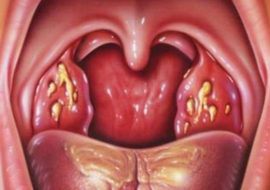 Not cured to the end of a sore throat. Self-medication or interruption of antibiotic therapy contributes to the justification of pathogens in the organ. With a weakening of immunity, they actively multiply, and an exacerbation of the pathology occurs.
Not cured to the end of a sore throat. Self-medication or interruption of antibiotic therapy contributes to the justification of pathogens in the organ. With a weakening of immunity, they actively multiply, and an exacerbation of the pathology occurs.- The development of caries, periodontitis, periodontal disease and other infectious diseases in the oral cavity. The presence of a constant source of pathogens provokes inflammation in the tonsils.
- Frequent inhalation of air by mouth. Hyperplasia of the nasal septum, their curvature and other reasons why nasal breathing is difficult.
According to the WHO, chronic and acute tonsillitis are the second most common among all diseases. The first place was awarded to caries.
Among the other reasons that lead to the formation of purulent plugs on the tonsils are:
- ecological problems;
- smoking;
- allergic reactions;
- structural features of the glands;
- immunodeficiency;
- hereditary predisposition.
Since during the inflammatory process in the focal area there is an intensive movement of blood flow and lymph, infectious agents can spread throughout the body and contribute to its intoxication. Such a process leads to drowsiness, weakness, distraction. And also to exacerbation of chronic diseases or the emergence of new ones, for example, pneumonia, prolapse of the heart valve, rheumatism of the joints.
Concomitant symptoms
Caseous plugs in the throat against the background of lacunar tonsillitis do not pose a great danger. Usually they are accompanied by perspiration and bad breath, which occurs due to the decomposition of food residues and components of the formations under the influence of hydrogen sulfide. Sometimes patients feel the presence of a foreign body, but only if caseoses are large.
Severe symptoms develop if plugs with pus form in the throat against a background of follicular, phlegmonous tonsillitis or chronic tonsillitis. A person will be disturbed by:
- soreness when swallowing food;
- increase in body temperature;
- fetid breath;
- swelling of the tonsils;
- tickle;
- intoxication.
As a result of such pathologies, connective tissue can grow, which leads to a change in the normal appearance of the oropharynx. Another possible complication is tonsil displacement in the opposite direction..
Caseoses are easily recognizable by the white curd coating that covers the tonsils. Since the stones are located deep in the cavity of the gaps, the patient himself cannot see them, only external manifestations are available to him.
Diagnosis of the disease
The doctor diagnoses the presence of caseous plugs in the gaps based on:
- medical history - patient complaints and information about previous or concomitant diseases;
- general examination and palpation;
- instrumental research;
- laboratory tests that help determine the microflora of the glands.
To confirm chronic tonsillitis, an ECG and radiography of the paranasal sinuses and nasopharynx are sometimes prescribed.
Conservative therapy
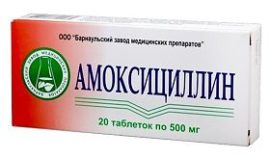 Treatment of tonsillitis, which is aggravated by plugs, is aimed at alleviating the symptoms and eliminating the pathogen. Of the antibacterial agents, Amoxicillin, Cephalexin, Oxacillin are most often prescribed.The therapeutic course is about 10 days. Sometimes the doctor recommends the use of macrolides, for example, Sumamed, Erythromycin. Such medicines should not be treated for longer than 3 days.
Treatment of tonsillitis, which is aggravated by plugs, is aimed at alleviating the symptoms and eliminating the pathogen. Of the antibacterial agents, Amoxicillin, Cephalexin, Oxacillin are most often prescribed.The therapeutic course is about 10 days. Sometimes the doctor recommends the use of macrolides, for example, Sumamed, Erythromycin. Such medicines should not be treated for longer than 3 days.
All antibiotics must be taken strictly according to the scheme determined by the doctor. Before use, bacterial culture should be given to determine the sensitivity of the pathogen to the drug.
In any inflammatory process, treatment of the lesion with antiseptic agents is indicated. Inflammation of the tonsils with the formation of tonsillitis plugs can be treated with the help of drugs: Furacilin, Rotokan, Miramistin, Chlorhexidine. Instead of solutions, antiseptics in the form of tablets and lozenges can be prescribed: Septolete, Faringosept, Strepsils.
If inflammation occurs with an increase in body temperature, antipyretic drugs are taken: Ibuprofen, Nurofen. And to relieve swelling of the mucous membranes of the tonsils - antihistamines, for example, Loratadin, Tsetrin, Zirtek.
Physiotherapeutic procedures
Physiotherapy is aimed not at removing plugs from the tonsils, but at reducing the activity of inflammation in the tissues and preventing the progression of pathology. They are not recommended for use during an exacerbation.
Types of procedures:
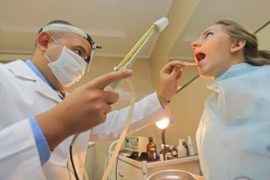 UV exposure. The effectiveness of the method is due to the fact that UV rays are able to destroy bacteria. The duration of the course is 10-15 sessions. A targeted effect on the foci of tonsillolitis prevents further accumulation of pus and an increase in traffic jams.
UV exposure. The effectiveness of the method is due to the fact that UV rays are able to destroy bacteria. The duration of the course is 10-15 sessions. A targeted effect on the foci of tonsillolitis prevents further accumulation of pus and an increase in traffic jams.- Laser irradiation. It has an antimicrobial effect and improves blood circulation in the affected lacunar region. During the procedure, the patient does not feel pain, it lasts no more than 5 minutes. Treatment course - 6 sessions.
- Ultrasonic aerosols. The principle of the method is the introduction of drugs into deep almond gaps by means of an ultrasound device. Thanks to him, medicines come to the most inaccessible places, which increases the expediency of their use.
Physiotherapeutic procedures and drug treatment contribute to the improvement of the state in traffic jams in the tonsils. But complete recovery is not achieved with them. Purulent plugs can be located not from the side of the throat, but in the depths of the gaps, so you can remove them only with the help of mechanical or hardware cleaning.
Traffic Removal
To get rid of tonsillitis plugs forever, they need to be removed. Typically, the procedure is carried out in one of several ways: by washing, by using a special apparatus or by surgical intervention. The last option is the most radical. They resort to it only as a last resort: if complications of purulent tonsillitis can occur.
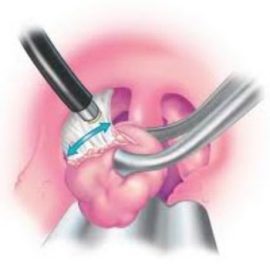 This condition is characterized by a significant increase in sore throat. An increase in temperature to 40 ° C, an increase in the phenomena of intoxication are noted. The neck swells in the affected area, and usually a swelling appears on one side. Pus and tonsillitis in the visible region are absent.
This condition is characterized by a significant increase in sore throat. An increase in temperature to 40 ° C, an increase in the phenomena of intoxication are noted. The neck swells in the affected area, and usually a swelling appears on one side. Pus and tonsillitis in the visible region are absent.
With lacunar angina, purulent plugs can be removed by mechanical cleaning. The doctor presses with a spatula on the outer arch of the tonsil - and liquid pus comes out.
Washing the lacunae
Doctors wash their tonsils using a syringe equipped with a cannula at the end. Washing is carried out after the drug is introduced into the lacunae. The procedure is carried out 5 times, usually this is enough to remove all purulent formations. But the method may be ineffective if the lacunae moves are too winding and deep.
Video:
Hardware Removal
Washing tonsils does not always give results, as plugs can form in the depths of the gaps. In such cases, another method of extracting almond stones is used - using the Tonsillor apparatus.After the introduction of this method into medical practice, the effectiveness of the treatment of tonsillitis doubled and the number of operations performed to remove the tonsils decreased four times.
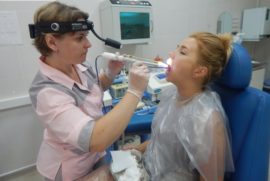 The principle of operation of the apparatus is to extract the contents of the almond canals using vacuum. After the procedure, the organ must be washed, this is done using ultrasound and phonoresis.
The principle of operation of the apparatus is to extract the contents of the almond canals using vacuum. After the procedure, the organ must be washed, this is done using ultrasound and phonoresis.
The ultrasound used in the device is capable of:
- lead to the death of bacteria;
- soften the stones in the gaps;
- improve blood circulation at the site of the lesion;
- slow down the formation of scar tissue;
- create a high concentration of drugs in the focus of inflammation.
You can get rid of pus in the gaps using the hardware method in 10 sessions. To fix the result forever, it is recommended to repeat the procedure after 6 months. If after applying the method the patient continues to complain of sore throat, the doctor will advise you to rinse the tonsils with antiseptics: Teraflu LAR, Strepsils plus.
Surgical intervention
With significant changes in the tonsils with a complete loss of their function, the organs are completely removed. If the processes are reversible, methods are used to partially eliminate those areas of the tonsils where white plugs appeared.
Tonsillolitis is removed under local anesthesia. There are many techniques for performing the operation: the method of excision with scissors or a wire loop is often used, a little less often with an infrared laser. The latter method allows you to cut and connect fabrics, and the temperature in them rises insignificantly.
If the tonsils are removed by laser, the postoperative period will pass with minimal pain, without bleeding and swelling. But the method is used only for adults, for children under 10 years of age it is unsafe.
Treatment of caseous traffic jams at home
Removing plugs from tonsils at home is unlikely to succeed. Such manipulations are rarely successful, moreover high risk of damage to the soft mucous membranes of the oral cavity, which can lead to inflammatory processes. However, in the treatment of chronic tonsillitis and as a prophylaxis of the formation of almond stones, folk methods are used.
To soften surface plugs, you can rinse your mouth with decoctions and solutions prepared at home. Recipe Options:
 Lemon juice, beets and honey are mixed in equal proportions, diluted with water. The mixture is kept in the mouth for more than two minutes, the recommended rinse frequency is 7 times a day.
Lemon juice, beets and honey are mixed in equal proportions, diluted with water. The mixture is kept in the mouth for more than two minutes, the recommended rinse frequency is 7 times a day.- Pharmacy collection, consisting of dogrose, calamus, peony root, grass of a volodushka or St. John's wort, root of a leuzea, rosemary is brewed in 250 ml of water, insist. The tool can be used not only for gargling, but also for ingestion.
Features of treating children
In children, tonsil plugs appear more often than in adults. And since their immunity has not yet been strengthened, antibiotic therapy and especially the removal of the tonsils are used only as a last resort, which complicates the treatment of tonsillitis.
The only safe and productive method is regular gargling and gargling. In both cases, only proven agents with a hypoallergenic effect should be used.
If gentle methods are ineffective, antibiotic therapy is involved. The entire treatment course, the child should remain under medical supervision, and parents should not go beyond the prescribed treatment.
Preventive actions
To avoid the formation of pus and purulent plugs in the tonsils, the following rules must be observed:
- Brush your teeth twice a day: morning and evening.
- To clean the oral cavity from food debris after each meal.
- Timely cure tooth decay and other diseases of the oral cavity.
- Get rid of pathologies of the sinuses and larynx.
- Stick to the basics of good nutrition.
- If necessary, strengthen the immune system with the help of vitamin complexes.
- Avoid hypothermia.


